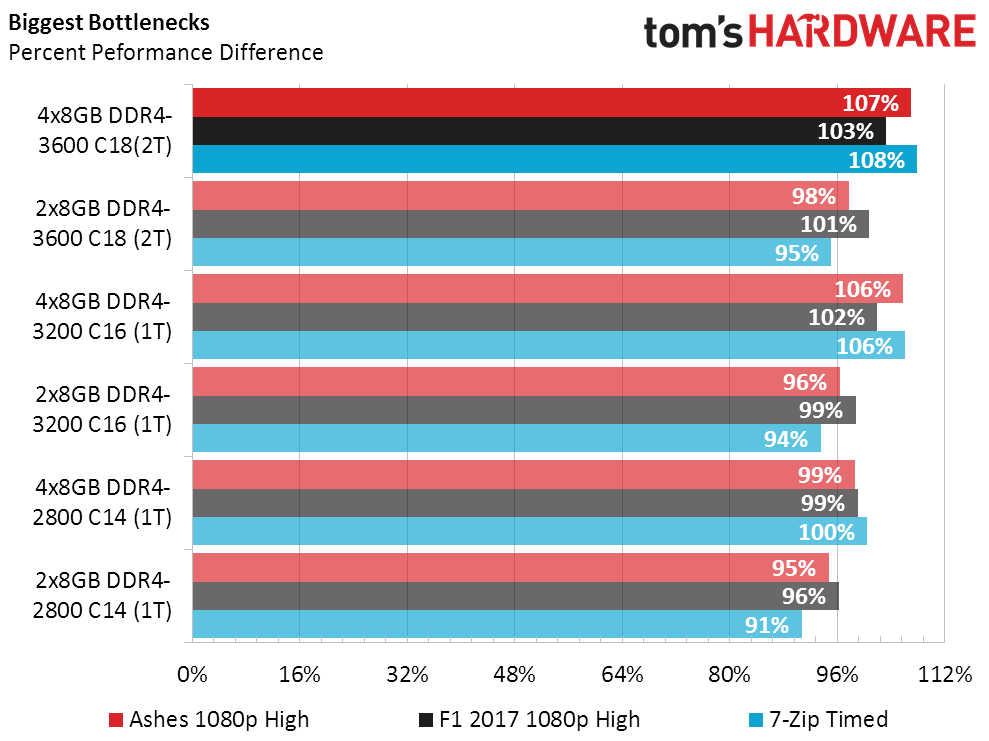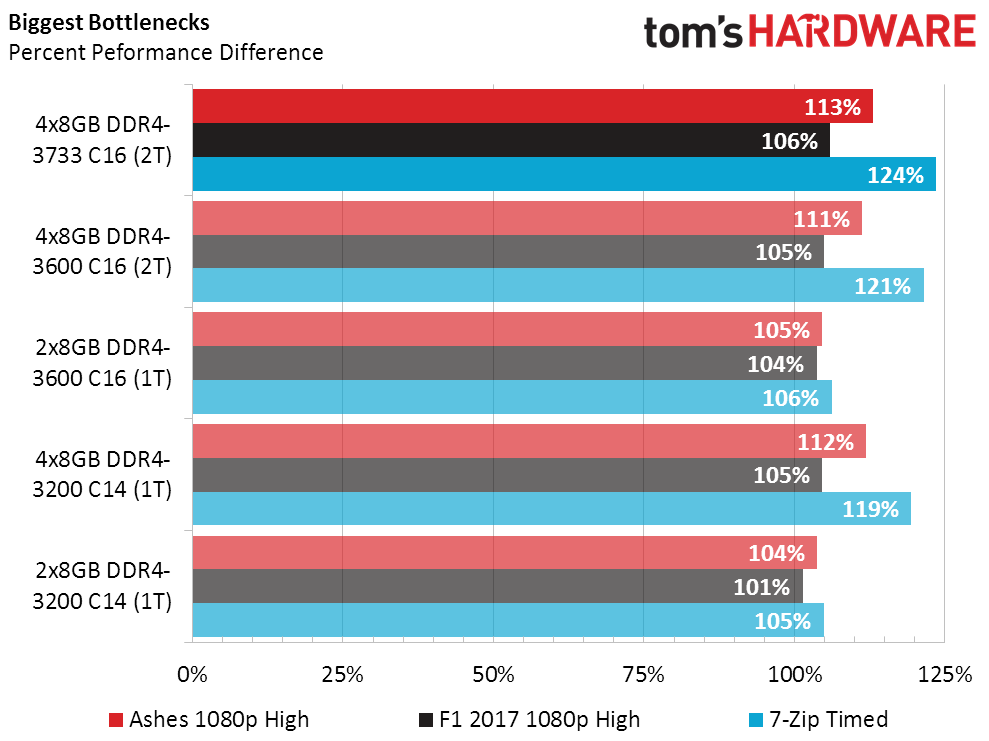Ryzen Above: Best Memory Settings for AMD's 3000 CPUs, Tested
Organization: Why Do I Want Four Ranks?
Why you can trust Tom's Hardware
A rank comprises the memory that connects to one 64-bit side of a DIMM. Most of these ICs are eight-bit, so that eight ICs in parallel compose a single 64-bit interface. Each module has two 64-bit interfaces, one in each side, which is why it’s called a Dual Inline Memory Module. A dual-rank DIMM has two interfaces filled with memory, while a single-rank DIMM has a filled side and an empty side.
Time and time again, we’ve seen proof that two ranks of memory per channel can significantly outperform one rank per channel. That’s probably due to interleaving, where for example one rank can start an operation while the other is finishing—think of it as latency overlap. It doesn’t matter whether those two ranks come from two single-rank DIMMs or one dual-rank DIMM, the performance improvement is the same.
A dual-channel motherboard with two ranks of memory per channel will have four ranks of memory. The problem for current buyers who want their 16GB to be spread across four ranks is that the 4Gb integrated circuits (ICs) that made up those 16GB quad-rank kits are no longer available. Most of today’s DRAM ICs have eight gigabits capacity, so that an eight-chip rank has 8GB capacity and four of those have 32GB capacity. Alternatives include buying very old memory with 4Gb ICs or very cheap memory with 8Gb ICs that have a 16-bit interface (so that four ICs make up a rank). Neither of those alternatives sounds very appealing.
We’ve already used a four-rank set of lower-density memory to show that our benchmarks don’t benefit from more than 16GB capacity when the number of ranks is the same, but how much more performance does four ranks really have than two?
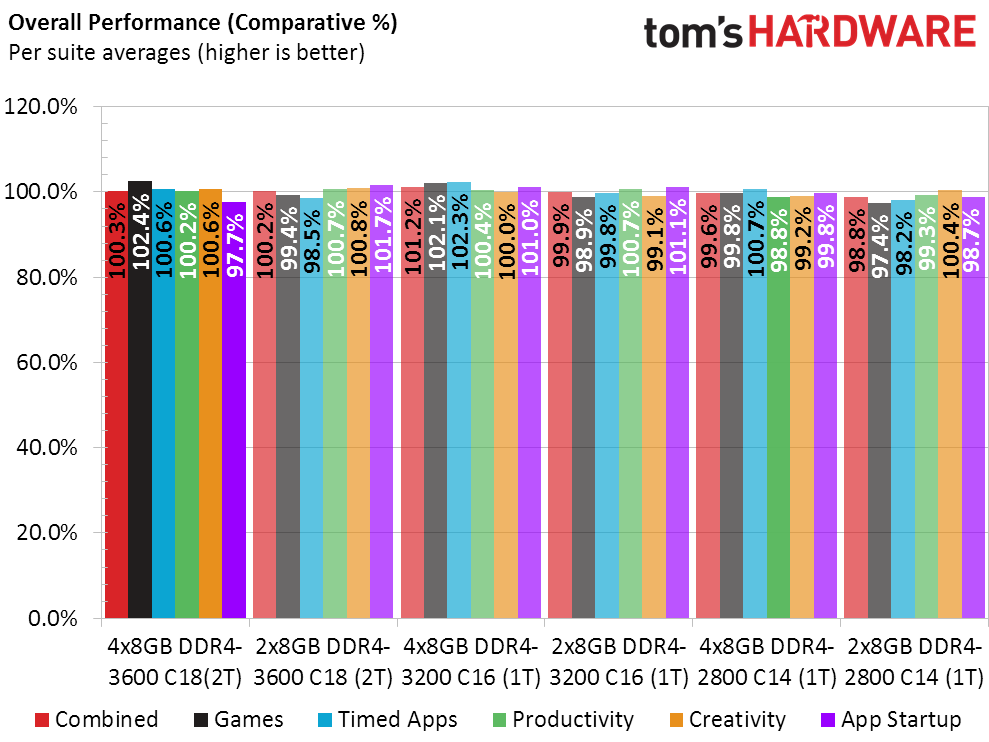
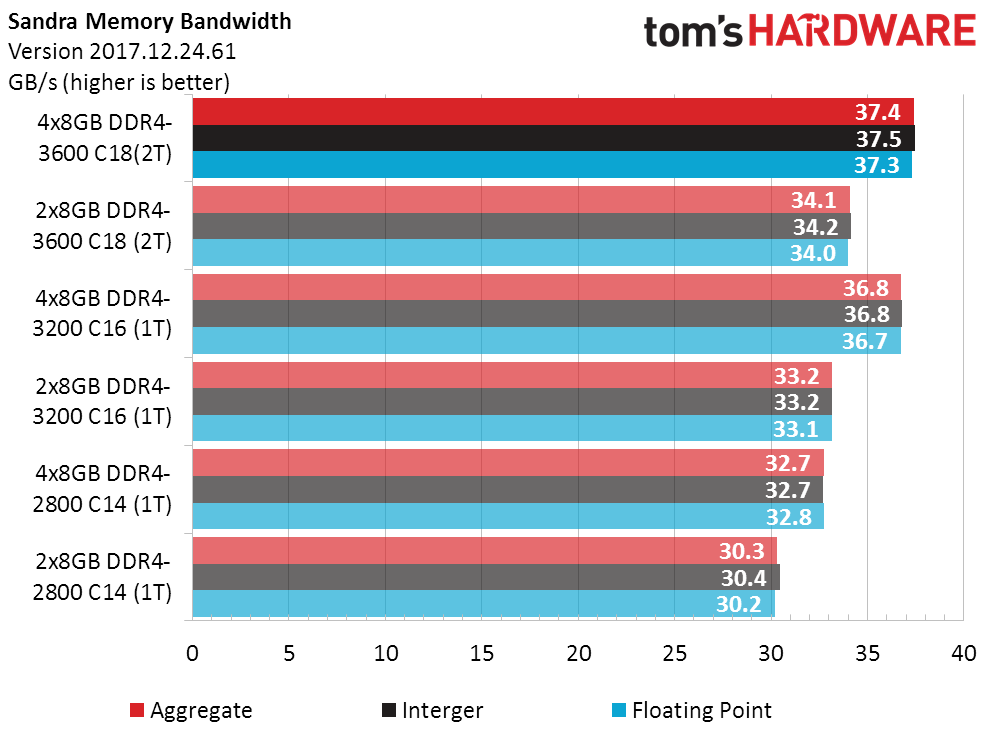
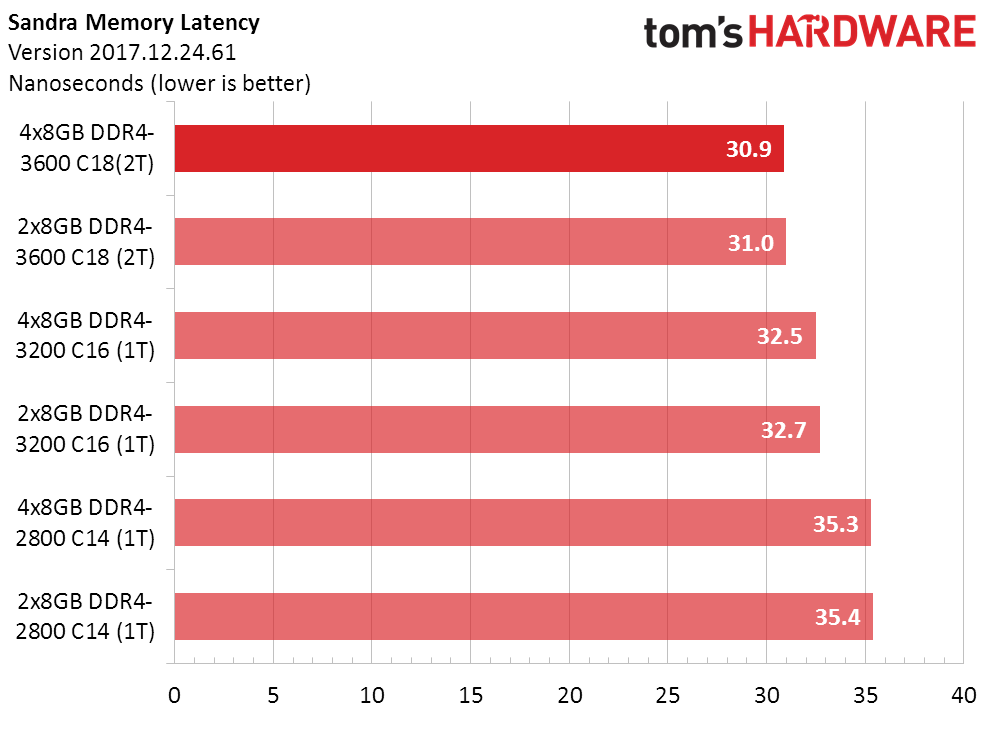
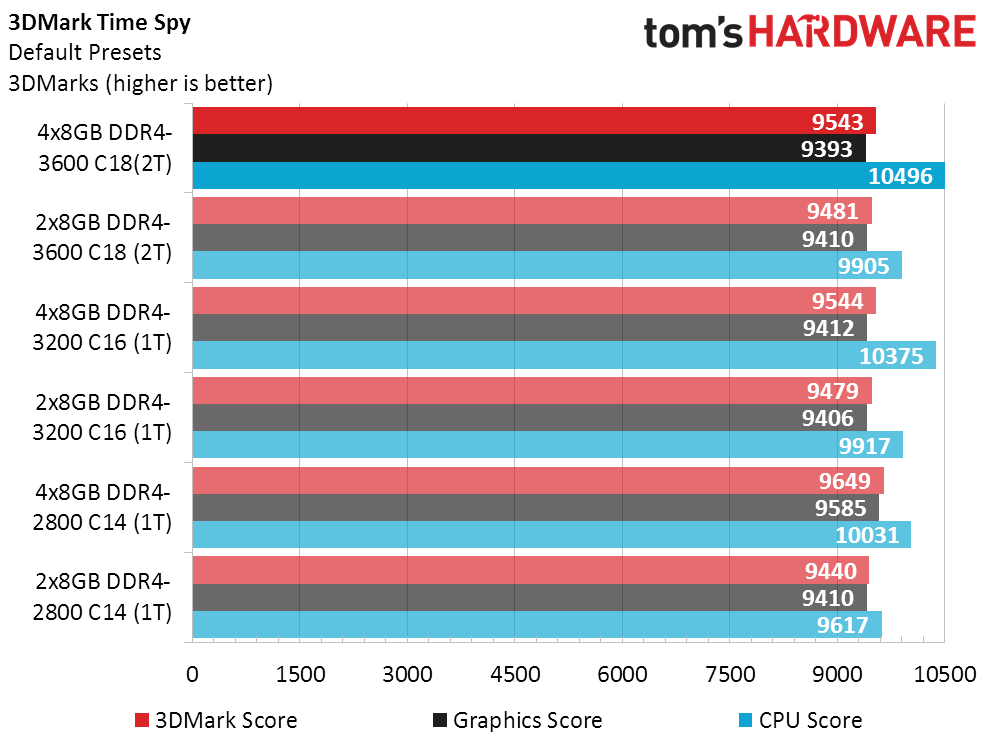
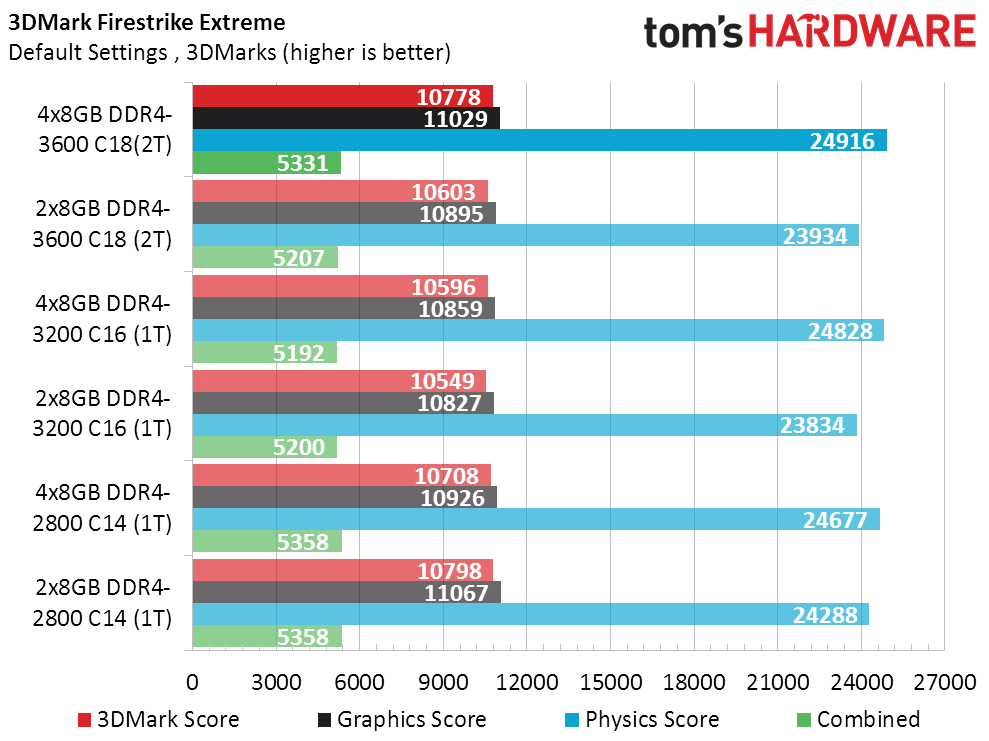




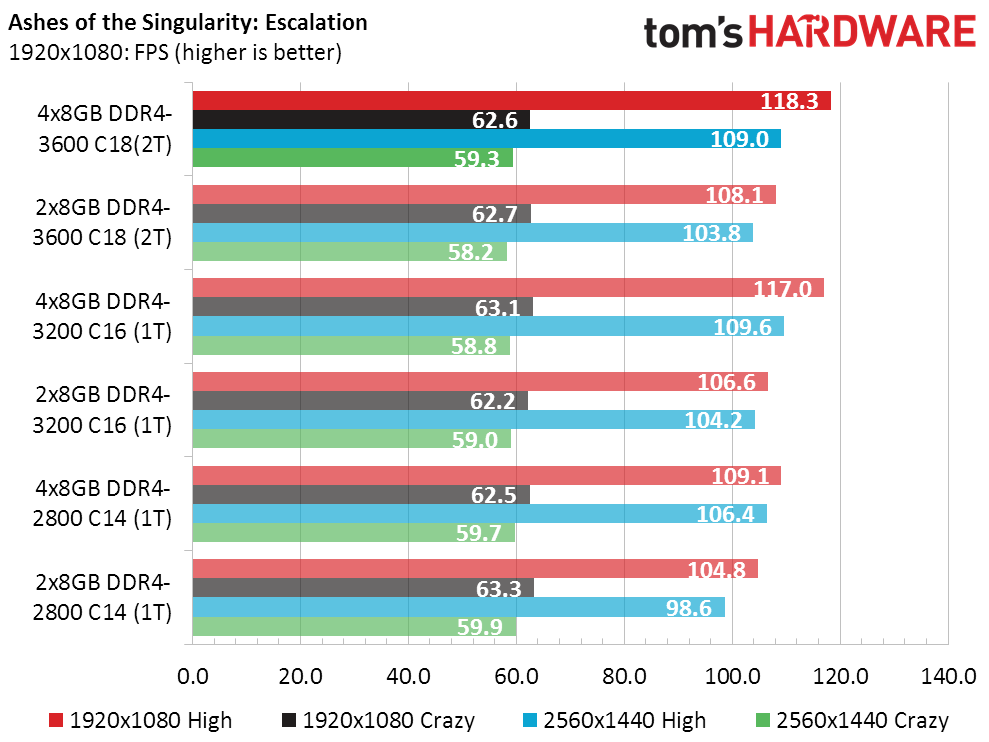

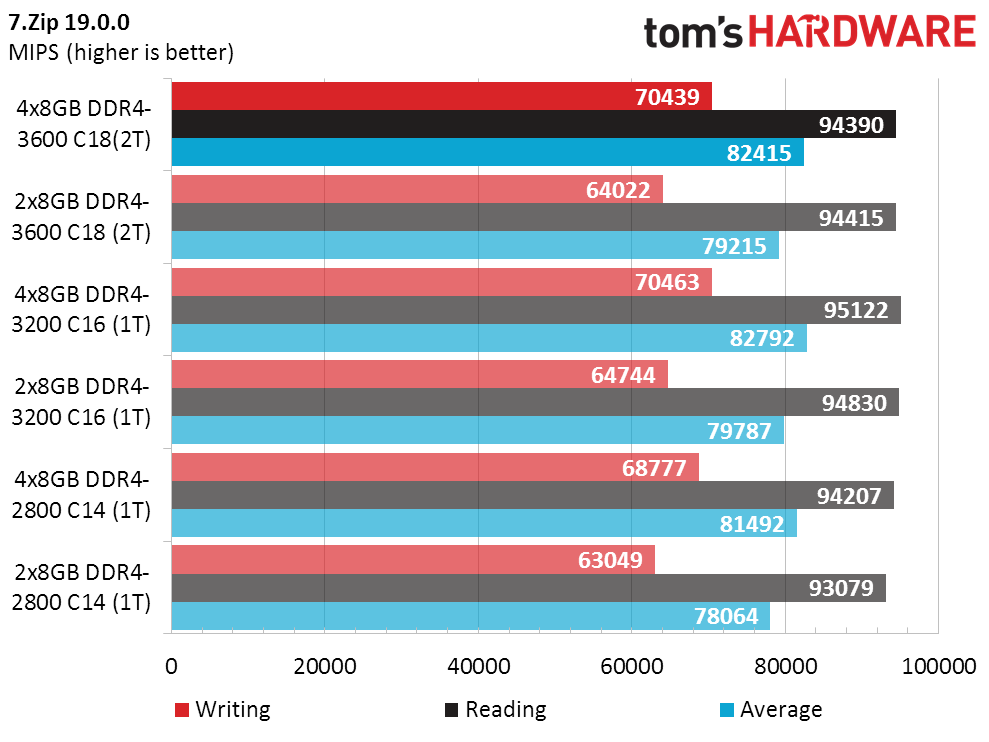
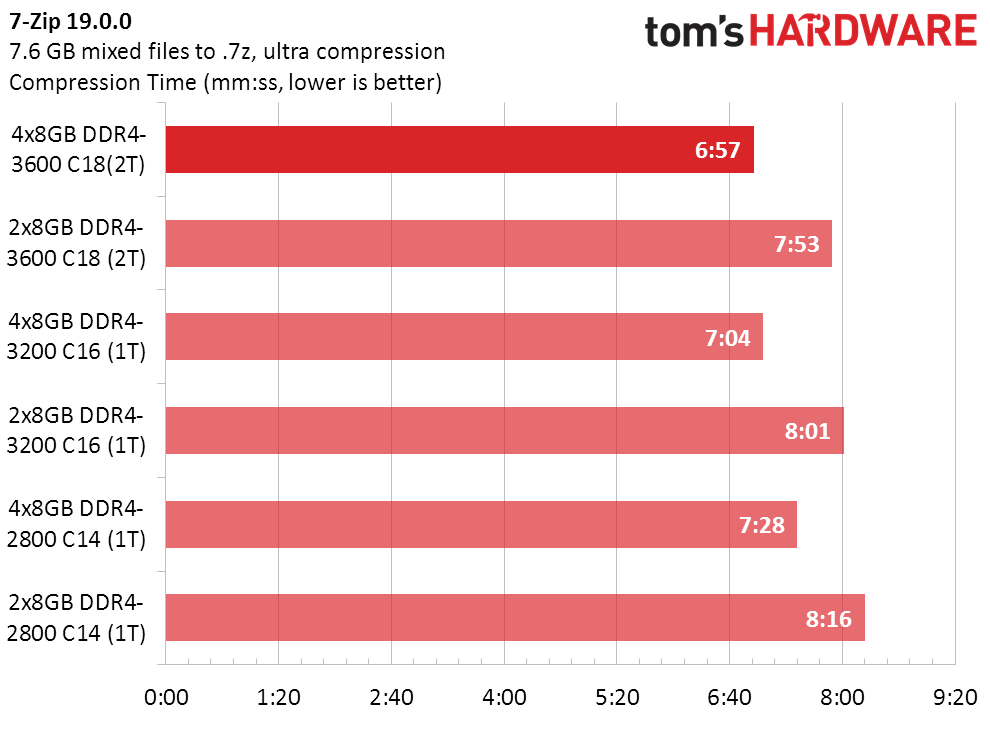

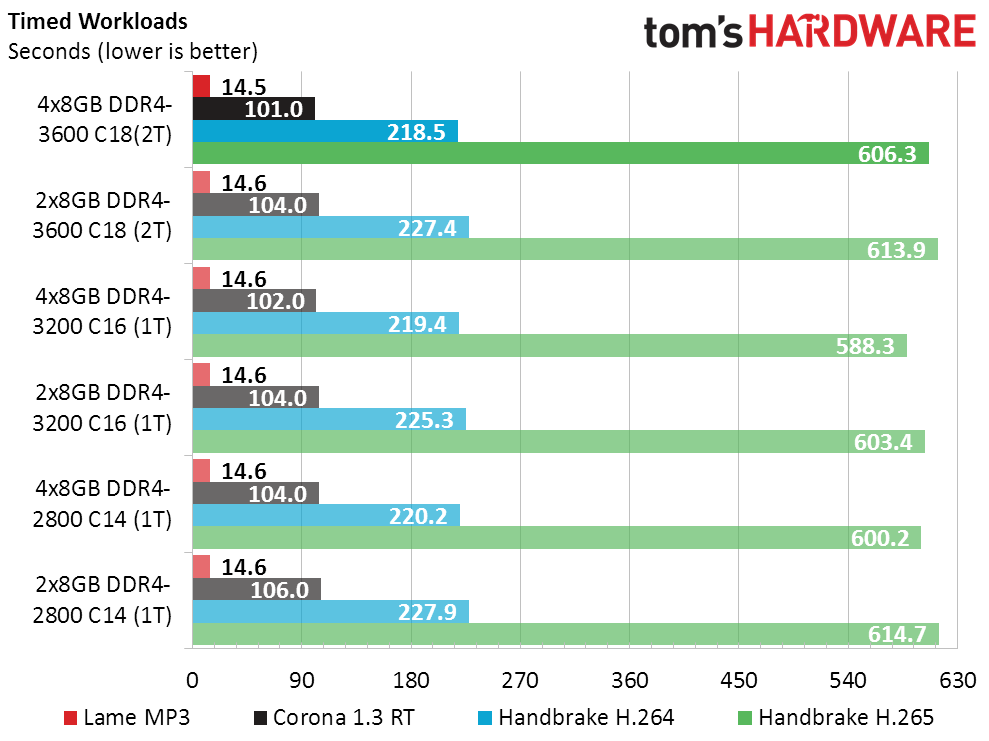
The numbers appear to be all over the place when so many benchmarks are averaged in our overall performance chart for this change, but there appears to be a trend of four-rank configurations outperforming two. Things get interesting when we limit our focus to benchmarks that we know have memory bottlenecks:
Would you have believed that you could increase your frame rates by up to 10% in Ashes simply by using four ranks of memory? Or that you could reduce file compression time by up to 13%? Isn’t that performance gain similar to upgrading to the next level of graphics card or CPU? Given that 8GB per-rank capacity fills the enthusiast market, isn’t this a good enough reason for us to recommend 32GB to gamers, even to those who will never need more than half of its total capacity?
The DDR4-3600 Limit: Should I Try DDR4-3733 Anyway?
For the most part, the best configurations for DDR4 (and even DDR3) performance have been at multiples of 266.6x MHz, but DDR4-3600 doesn’t fit that scheme. Since we’re unwilling to take our DDR4-3600 all the way down to DDR4-3466, one might wonder why we don’t simply jump up to DDR4-3733? For Ryzen 3000, the answer lies within the assumed stability limitation of its I/O die. AMD switches its onboard Unified Memory Controller frequency (UCLK) to 1/2 of the DRAM data rate whenever DDR4-3600 is exceeded, and further protects controllers on the I/O die from instability by decoupling its Infinity Fabric clock when exceeding that frequency.
Now that we’re using an X570 test platform for memory reviews, we’ve seen plenty of proof that DDR4-3733 can lower performance compared to DDR4-3600 when those controllers are allowed to employ AMD’s default limitations. But hey, 1866 MHz (the clock rate for DDR4-3733) is only 66MHz higher than AMD’s approved 1800 MHz (the clock rate for DDR4-3600), and 66 MHz shouldn’t be that much of a reach, right?
Overclocking doesn’t get much simpler than this: We left motherboard firmware at the default DDR4-3600 timings and simply bumped its frequency up to DDR4-3733, followed by manually configuring the FCLK frequency to 1867 MHz and the UCLK frequency ratio at 1:1. MSI firmware’s CPU NB/SoC voltage was already set to 1.10V for our other tests: Would the system remain stable enough to complete our benchmarks without further voltage increases?

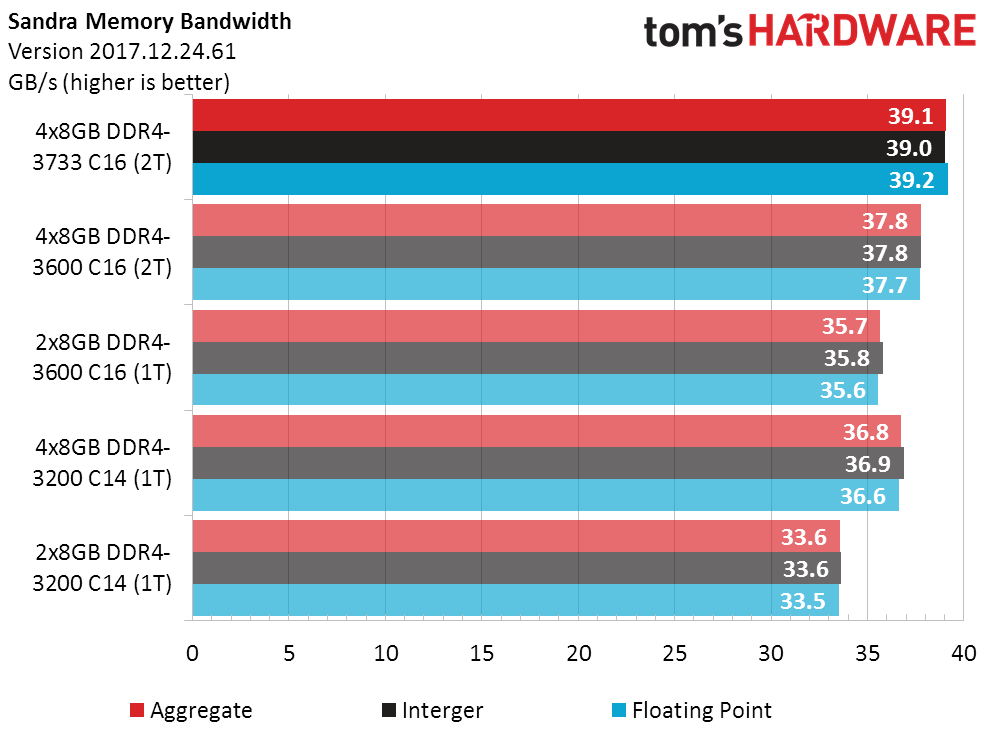


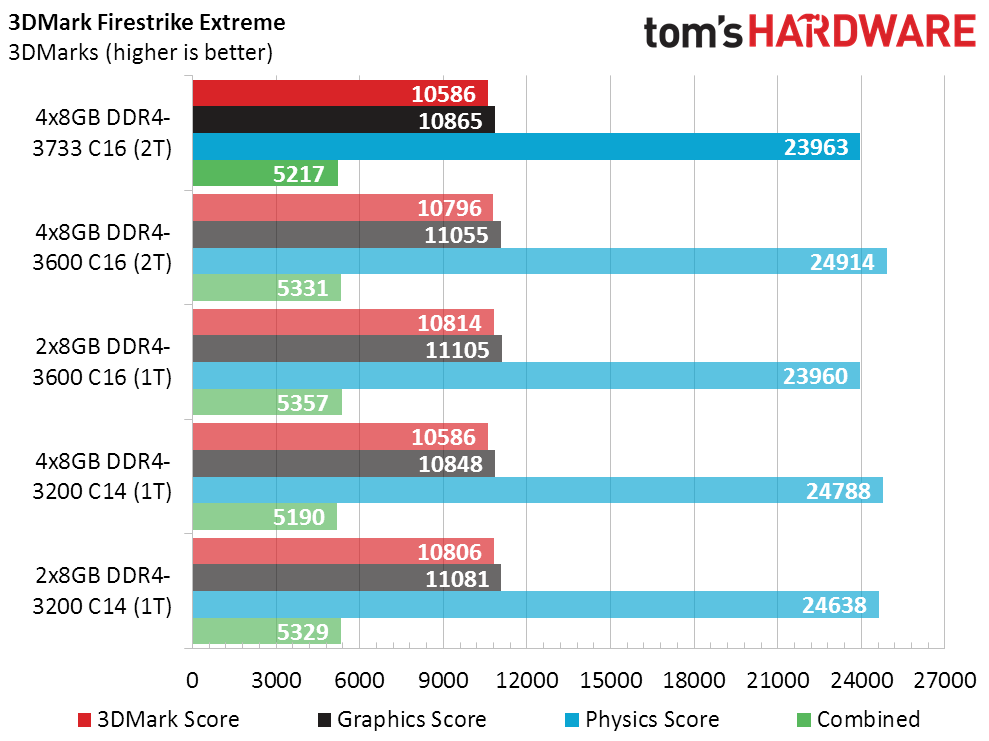

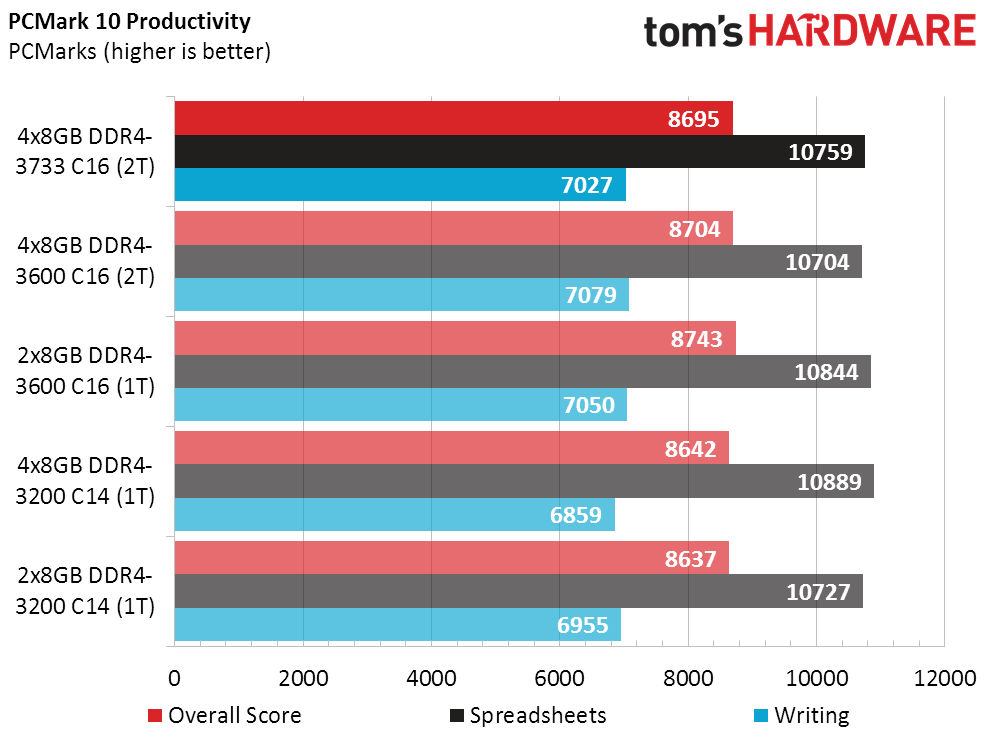
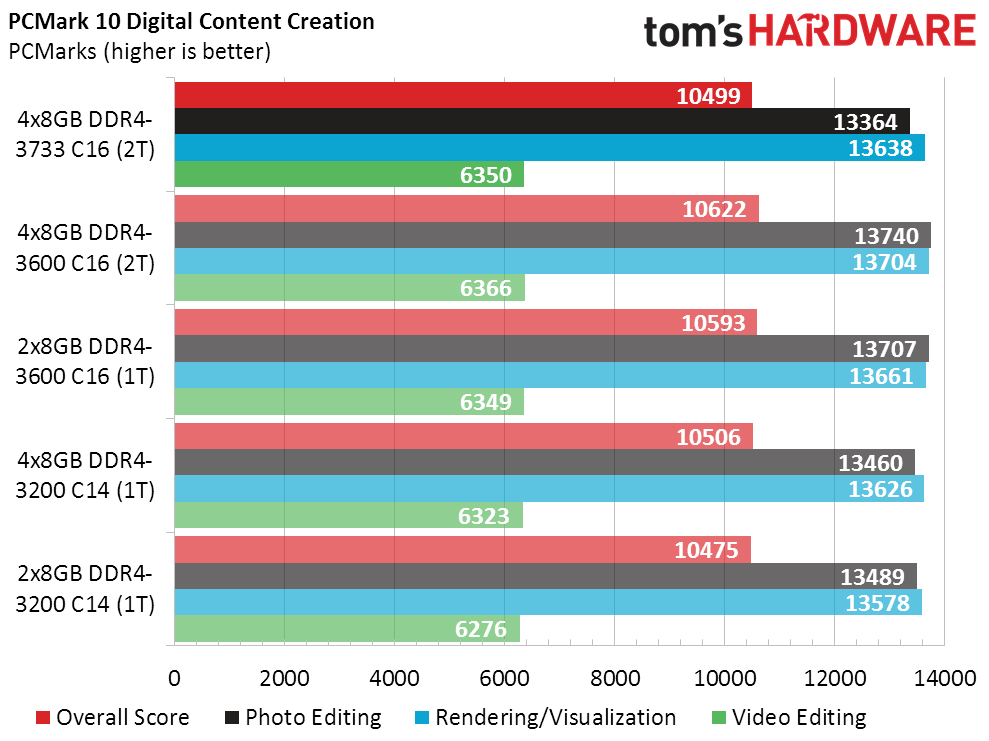
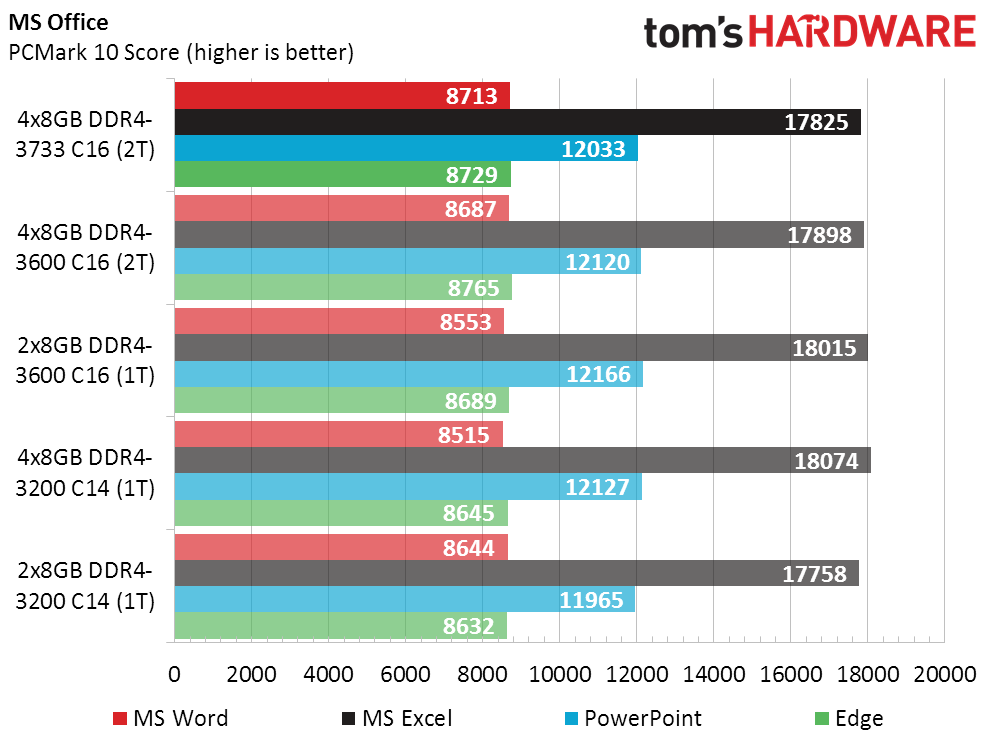
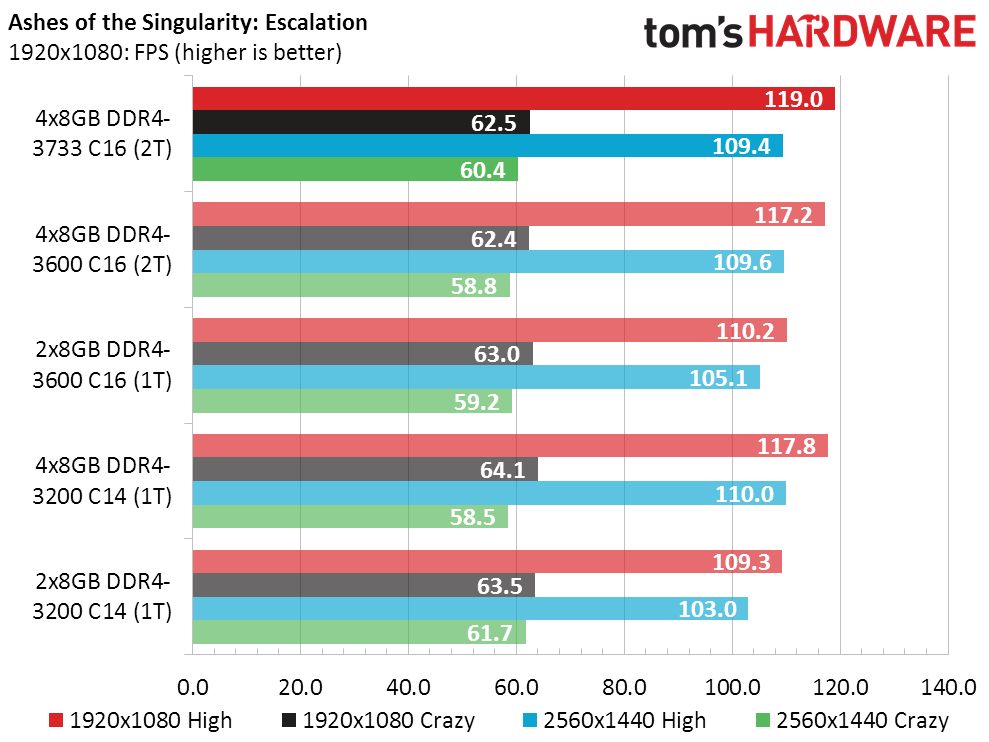


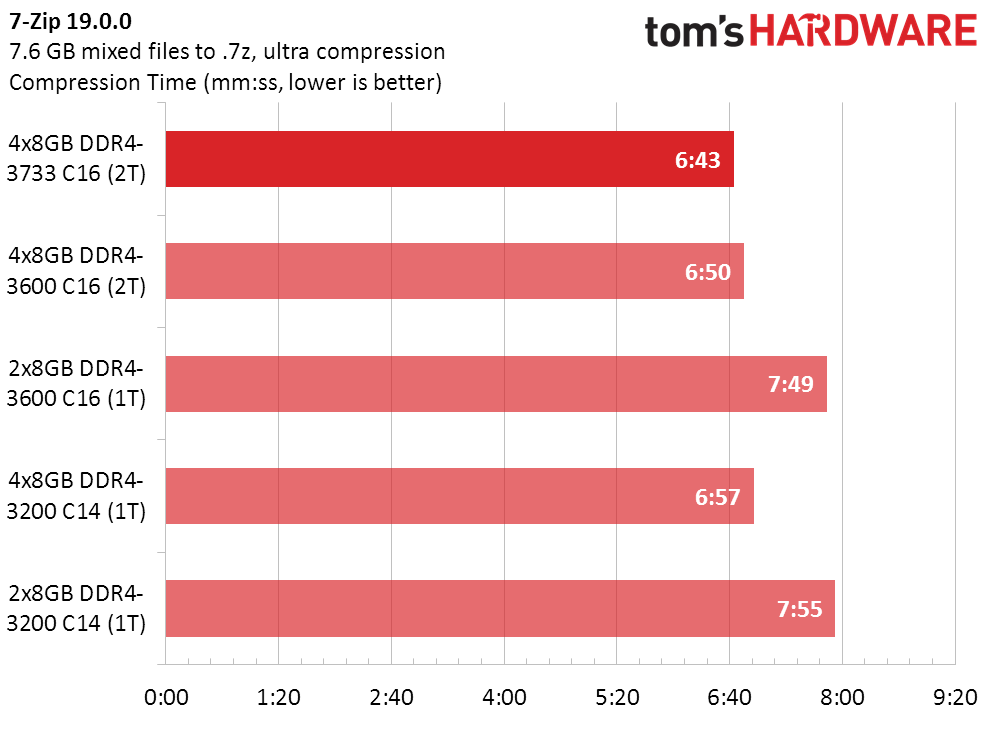
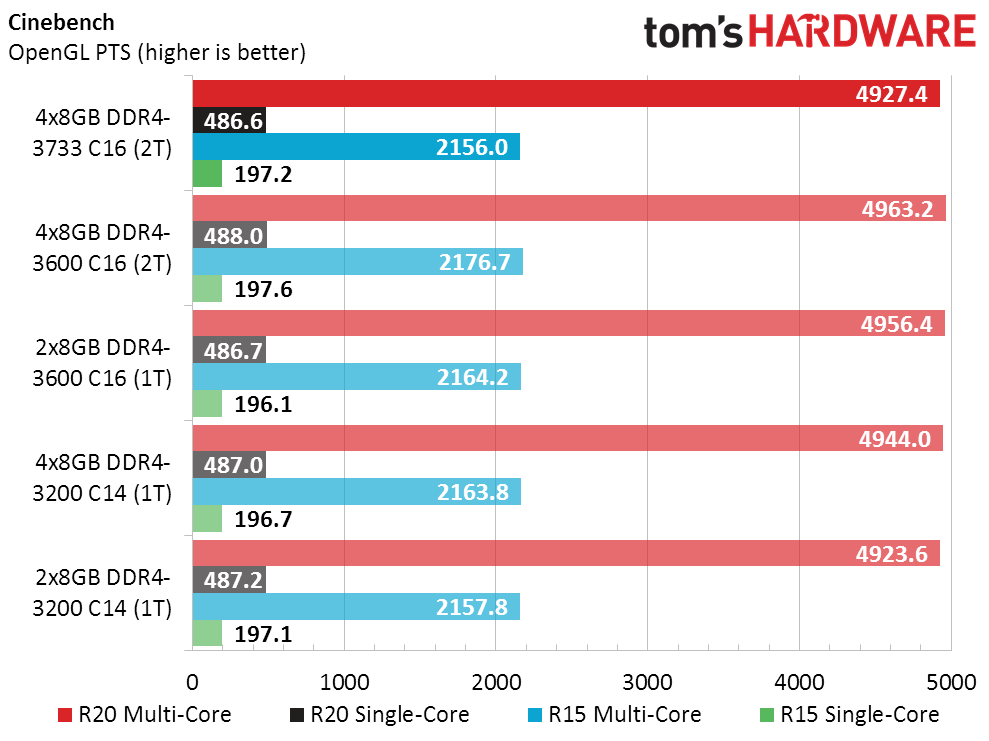
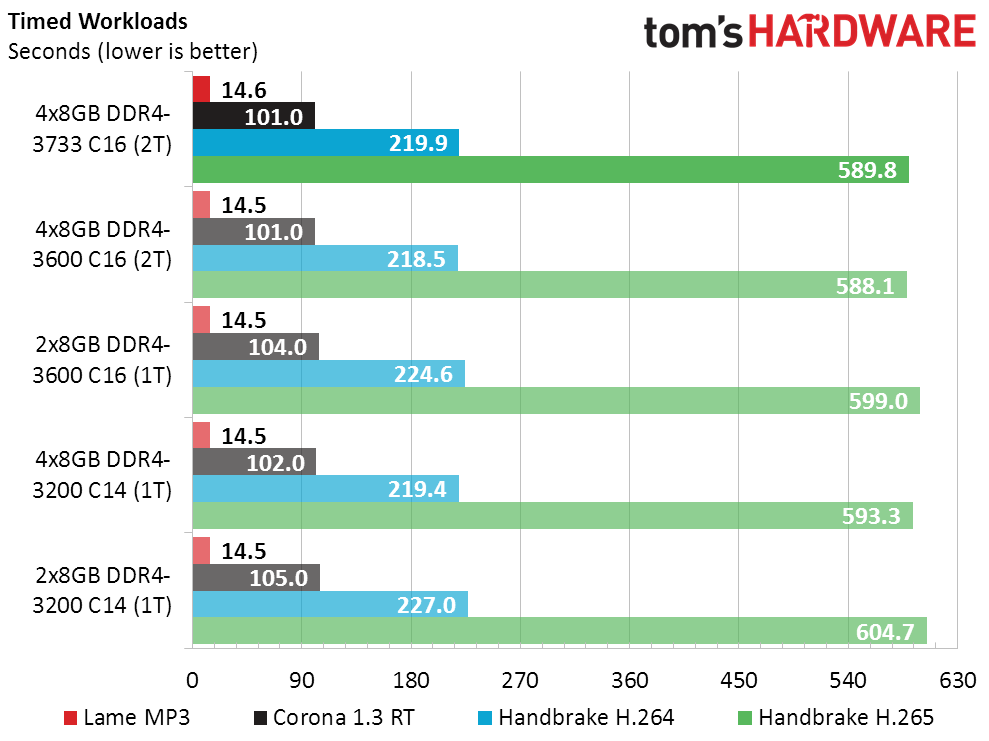
Since this is an overclocking section, we based our charts (100% rating) on the standard for which we were told Ryzen 3000 is optimized: 2x8GB DDR4-3200 C16. We can see that nearly every alternative performs better to some degree, but we really need to dive into the image gallery to see pronounced differences. Or, as usual, we can skip to the highlights.
There’s what we want to see. If you can run AMD’s controllers stably at 1:1 ratios, DDR4-3733 will give you up to 3% better performance than DDR4-3600. Four ranks of memory will give you up to 15% more performance than two, even when those four ranks have the disadvantage of 2T timings. The one place where it payed to slow our four DIMMS from DDR4-3600 to DDR4-3200 was in Ashes, where the lower data rate got the advantage of using a 1T command rate.
Ryzen Way Beyond The Basics
The easy conclusion is that every enhanced setting that you’d expect to boost the performance of AMD’s Ryzen 3000 series CPUs, does, that it’s not optimized for any specific data rate but scales proportionally with all stable data rates. So here’s a short list of our findings—that is to say, confirmations:
- Going from two ranks to four ranks of memory is by far the best way to improve performance in memory-bottlenecked applications. At current memory density, that usually means having at least 32GB (even if you don’t think you’ll use that much capacity).
- Switching from 2T to 1T command rate provides a similar performance boost to shaving two cycles from CAS Latency.
- The only time DDR4-3200 C14 and DDR4-3600 C16 have similar performance is when the slower kit has the better (1T) command rate.
- Overclocking to DDR4-3733 provides a nice performance boost, but only if you’re able to stably do it with synchronized UCLK and FCLK.
- The best practical configuration is four ranks of DDR4-3600 at the lowest stable latencies. Reminder: Four ranks can be achieved from either four single-rank or two dual-rank DIMMs.
Keeping in mind that not every overclocking adventure produces the expected results, a 32GB DDR4-3600 C16 kit such as the one we used today is a great starting point and an acceptable finish line.
Photo Credits: Tom's Hardware
MORE: Best Memory
MORE: DDR DRAM FAQs And Troubleshooting Guide
MORE: All Memory Content
Get Tom's Hardware's best news and in-depth reviews, straight to your inbox.
-
NightHawkRMX So another test I want to see with ryzen 3000, faster speed ram with loose timings, or slower speed ram with tight timings.Reply -
Soaptrail So we should get 4x8GB RAM for Ryzen? I see on the reviews for Ryzen 3, the official support for 4 dimms at dual rank is only 2667. Can anyone confirm is it easy or hard to buy 4x8GB of dual rank and use it at 3600? i will do it but if it is a lottery of working or not I want to know.Reply
I have been building PC's for years but I never really got into overclocking other than XMP profiles. So i am willing to do this if it is easy enough to succeed. Thanks to anyone who helps explain this to me. I enjoyed this article but it was not as noob friendly as I needed. -
NightHawkRMX Ryzen is dual channel only.Reply
Just get 2x16gb and it will be more compatable and have better performance. -
salgado18 Reply
Care to show the tests to support your claim that 2x16 is faster than 4x8? Because the article you're replying to did just that, and proved the opposite.remixislandmusic said:Ryzen is dual channel only.
Just get 2x16gb and it will be more compatable and have better performance. -
NightHawkRMX Traditionally when running 4 sticks in 2 channels, you are usually forcing the command rate to 2T rather than 1T, making the ram latency worse.Reply
Heres what the article says:
"Command rate is the number of cycles a command must be presented before a memory operation commences, so that 2T incurs an additional cycle of latency to every memory access. It makes sense that most people would shoot for 1T, except that higher data rates often make this unworkable, particularly when more ranks of memory are used (ie, two “double-sided” or four “single-sided” DIMMs). The reason that we’ve used only half of our four-DIMM kit thus far is that it won’t run all four DIMMs at DDR4-3600 and 1T, hence you’ll want to see the penalty of 2T before we add four-DIMM configurations to the mix."
I see no way for 4 sticks to be faster as they have no more bandwidth than 2 sticks. If you look at the far right 2, you see the performance is roughly the same, which is very surprising. I have seen 4x8gb would have less compatability with ryzen in the past, but not sure of now.
-
CheckDM Hmm. This throws a curveball in my upcoming build, because I already want 32GB.Reply
I was simply going to go 2x16 with "Corsair Vengeance LPX 32GB (2x16GB) DDR4 DRAM 3200MHz C16" (CMK32GX4M2B3200C16) for $155.
But now I'm thinking I should go with a 4x8G with "CORSAIR Vengeance LPX 16GB (2 x 8GB) DDR4 3200" (CMK16GX4M2B3200C16) for a total of $140.
The 4x8 config is a little cheaper, and according to this article using 4 sockets is possibly better.
(However, the QVL sheet for my chosen motherboard, Gigabyte X570 Auros Elite, supports the 2x16 but the ram selected for 4x8 is only supported in 2x8. So this might be the overriding factor.) -
Z1NONLY 4 single rank sticks allow the controller to interleave the ram, making it faster than two single rank sticks. I have experienced this in my own 3800x build. Both time spy physics and shadow of the tombraider did better with 4 sticks of ram.Reply
As the article points out, with 4 sticks an operation can start on one rank while another has not yet finished on the other...and this is on each of the channels.
My TS physics score was ~10300 with two sticks and ~10700 with four. -
NightHawkRMX Reply
That makes sense.Z1NONLY said:4 single rank sticks allow the controller to interleave the ram, making it faster than two single rank sticks. I have experienced this in my own 3800x build. Both time spy physics and shadow of the tombraider did better with 4 sticks of ram.
As the article points out, with 4 sticks an operation can start on one rank while another has not yet finished on the other...and this is on each of the channels.
My TS physics score was ~10300 with two sticks and ~10700 with four. -
Crashman Reply
You should get four ranks of 8GB. The article says it doesn't matter if it's four single-rank or two dual-rank DIMMs.Soaptrail said:So we should get 4x8GB RAM for Ryzen? I see on the reviews for Ryzen 3, the official support for 4 dimms at dual rank is only 2667. Can anyone confirm is it easy or hard to buy 4x8GB of dual rank and use it at 3600? i will do it but if it is a lottery of working or not I want to know.
I have been building PC's for years but I never really got into overclocking other than XMP profiles. So i am willing to do this if it is easy enough to succeed. Thanks to anyone who helps explain this to me. I enjoyed this article but it was not as noob friendly as I needed.
Maybe I should repeat the above statement from the article body in its conclusion ;)CheckDM said:Hmm. This throws a curveball in my upcoming build, because I already want 32GB.
I was simply going to go 2x16 with "Corsair Vengeance LPX 32GB (2x16GB) DDR4 DRAM 3200MHz C16" (CMK32GX4M2B3200C16) for $155.
But now I'm thinking I should go with a 4x8G with "CORSAIR Vengeance LPX 16GB (2 x 8GB) DDR4 3200" (CMK16GX4M2B3200C16) for a total of $140.
The 4x8 config is a little cheaper, and according to this article using 4 sockets is possibly better.
(However, the QVL sheet for my chosen motherboard, Gigabyte X570 Auros Elite, supports the 2x16 but the ram selected for 4x8 is only supported in 2x8. So this might be the overriding factor.)
